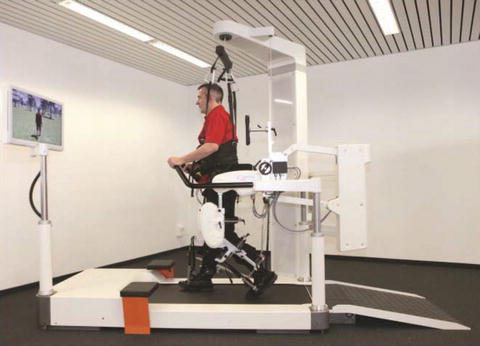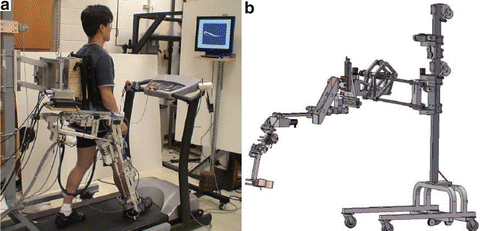Fig. 10.1
Gait Robot G-EO System (Reha Technology AG [19]) (Published with permission from Reha Technology AG)
The Pelvic Assist Manipulator (PAM) developed at the University of California at Irvine is a pneumatic robot for measuring and manipulating pelvic motion during stepping with a Body Weight Support (BWS) system over a treadmill [22]. The PAM allows naturalistic motion of pelvis, which is actuated by six pneumatic cylinders, that combined with a nonlinear force-tracking controller, provides backdrivability and large force output. Two cylinders lie coplanar in the horizontal plane, and the third cylinder lies in an oblique plane to provide upward forces. The system has five DoFs, providing control of three translations (side-to-side, forward-and-back, up-and-down) and two rotations (pelvic rotation, and pelvic obliquity). One rotation cannot be controlled, that of pelvic tilt. The PAM can act as a teach-and-replay device with a Proportional and Derivative (PD) position controller driving the pelvis onto the reference trajectory specified with or without a therapist’s help. Footswitches detect the gait timing and a feedback control algorithm adjusts the play-back speed of the gait pattern in real-time to help synchronizing the robotic assistance during stepping by unimpaired subjects, even when the subjects change their step size and period [23].
The Pneumatically Operated Gait Orthosis (POGO) was also developed at the University of California at Irvine together with the PAM, to provide assistance to the lower limbs. The POGO attaches to and works with PAM, preventing buckling of the knee during the stance phase of the naturalistic walking motion [22].
A robotic trainer called Natural and TUneable rehabilitation gait system (NaTUre-gaits), has been developed in Singapore for over the ground walking rehabilitation [24]. This device consists of a pair of Robotic Orthoses (RO) connected to a Pelvic Arm (PA) and mounted on a Mobile Platform (MP) [25]. The RO provides gait locomotion assistance for lower limbs, the PA provides actuated assistance for five pelvic movements (three translational and two rotational) and the BWS is provided during walking by using one single mechanism. The MP allows over the ground walking. A pelvic motion active BWS (pa-BWS) control strategy was developed for NaTUre-gaits to provide an active BWS, promoting active patient participation during the rehabilitation for a better therapeutic outcome. The scheme also aims at driving the pelvis along a reference trajectory for a natural gait [26]. Each motion is achieved by a linear sliding mechanism, actuated by a Direct Current (DC) servo motor [27].
The 6-DoF gait rehabilitation robot allows patients to exercise their walking velocity on various terrain types and navigate for diverse walking training in Virtual Environment (VE) through upper and lower limb connections, by estimating the interaction torques between the human and the upper limb device. This robot is composed of an upper limb device, as sliding device, two footpad devices, and a body support system. The footpad device on the sliding device generates three DoFs spatial motion in the sagittal plane for each foot. The upper limb device allows users to swing their arms naturally through the use of a simple pendulum link with a passive prismatic joint. Synchronized gait patterns for this robot are designed to represent a normal gait with upper and lower limb connections. In addition, the patient is able to navigate in the VE [28].
The MIT-Skywalker (Fig. 10.2) is a device developed for gait therapy based on the concept of passive walkers and the natural dynamics of the lower extremity to deliver more “ecological” therapy [30]. The fast donning and doffing alongside its dynamic principles and ecological intervention are the advantages of this device. A camera-based closed loop control facilitates safe and efficient control of the device, providing an effective and interactive gait therapy program, based on the real-time information of the patient’s leg motion [29].
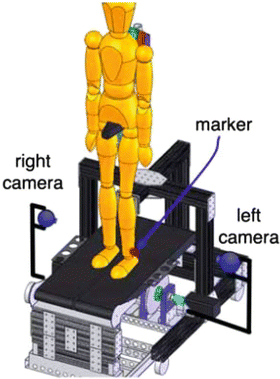

Fig. 10.2
The MIT-Skywalker platform [29] (Published with permission from Prof. Hermano Igo Krebs, Massachusetts Institute of Technology, Cambridge, MA)
The cable-driven robotic gait training system CaLT is a highly backdrivable, compliant robotic gait training system that gives patients the freedom to voluntarily move their legs in a natural gait pattern during body weight supported treadmill. It was designed to encourage active involvement of subjects in the treatment and allow freedom for subjects to control their stepping performance during treadmill training. The device provides a controlled assistance or resistance force to assure stable stepping and maximize patient effort; as well as to allow step-to-step variation in leg kinematics. This device applies forces to legs at the ankle level during treadmill stepping and studies have shown that with such therapy it is possible to improve the locomotor function in people with Spinal Cord Injury [31] and in patients post-stroke through robotic-assisted treadmill training [32].
A modular light-weight robotic system called STRING-MAN was developed by researchers at the Institute for Production Systems and Design Technology IPK in Berlin, Germany to assist in locomotion recovery therapy and gait training. This powerful robotic system provides functions for improving gait rehabilitation outcomes, especially those relevant to the restoration of posture balancing and gait motor functions. STRING-MAN combines modular wire robot components, advanced artificial muscle drives, reliable, and dynamically controlled weight-suspension and balancing system. This robotic structure is able to control the patient’s posture in six DoFs and allows the patient’s own initiative by using force or impedance control. Patients can autonomously perform gait recovery training in the early rehabilitation stage, because the system has the ability to adjust the interaction control from totally passive to completely active [33].
Another robotic device for gait and balance training is the KineAssist (Fig. 10.3) that focuses on increasing the level of challenge to a patient’s ability to maintain balance during gait training, permitting the direct involvement of a Physical Therapist. The KineAssist is microprocessor controlled, and uses control methodology developed for haptic displays. The motion of the mobile base is powered while the patient’s intent for motion is detected by passive sliders and integrated force sensors positioned in the pelvic support. Control algorithms move the base in response to a patient’s forces and motions. This actuated device provides Partial Body Weight Support (PBWS) and postural torques at the trunk, and allows many DoFs of the trunk as well as the pelvis. The KineAssist leaves the patient’s legs accessible to a physical therapist during walking. The device follows a patient’s walking motion over-ground in forward, rotation, and sidestepping directions and prevents falls. This device has seven programmable operation modes, ranging from low level setting for patients with impaired mobility on a basic functional level, to more advanced setting [34].
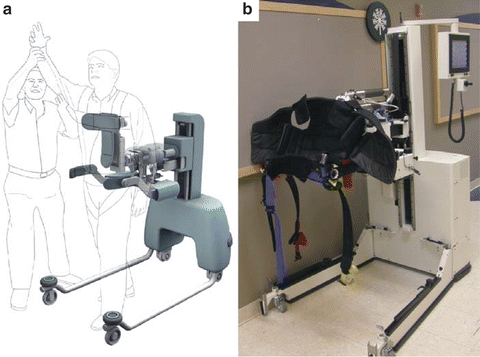

Fig. 10.3
(a) Artist’s rendition of the KineAssist in use with a physical therapist [34]; (b) KineAssist device (Published with permission from The Rehabilitation Institute of Chicago)
Two types of gait rehabilitation robot systems called “WHERE-I” and “WHERE-II” (Fig. 10.4) were developed by researchers of the Korean Advanced Institute of Science and Technology. WHERE-I is a mobile manipulator based on electrical BWS mechanism, whereas WHERE-II is a mobile vehicle with a one-link manipulator and a pneumatic BWS mechanism. Each system consists of four main subsystems: a mobile base, an actuated BWS, an intention analysis system, and a safety system. Both systems have electrical actuators for height adjust and ultrasonic sensors for safety. Three of the six axes of motion at the pelvis that are involved in walking are inhibited. These devices can move forward/backward and can rotate in place. The BWS system unloads and controls the up-and-down motion [35].
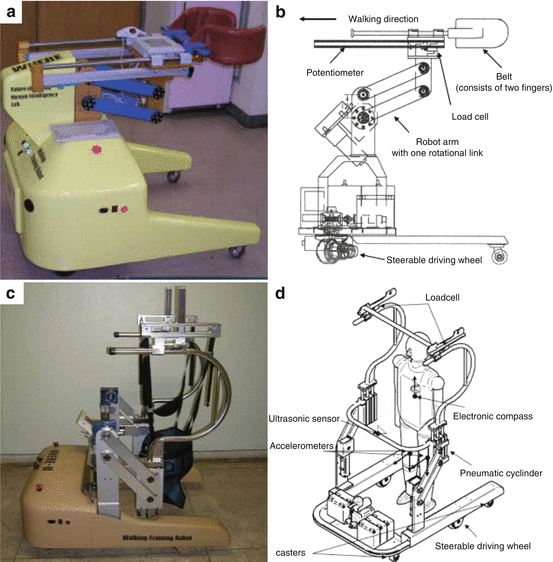

Fig. 10.4
(a) WHERE-I prototype; (b) WHERE-I CAD drawing; (c) WHERE-II prototype; (d) WHERE-II CAD drawing [35] (Published with permission from Dr. Kap-Ho Seo)
10.3 Exoskeleton Type Lower Limb Rehabilitation Robotic Devices
The Driven Gait Orthosis (DGO) is a rehabilitation robot developed at the Rehabilitation Center ParaCare, of the University Hospital Balgrist in Zurich (Switzerland). The DGO performs locomotor training for paraplegic patients (Spinal Cord Injury – SCI) and post-stroke survivors. The device is adjustable to individual needs, has a BWS system and four DoFs. A position controller regulates actuators at the knee and hip joints in the sagittal plane. The first version of the DGO with position control strategies did not allow voluntary active movements of the patient [12, 36]. A new version had a cooperative control architecture based on impedance control that allowed patients to accomplish free walking movements. Impedance control motivates patients and accelerates the rehabilitation progress [13]. The DGO was commercialized as the ‘Lokomat®’ – Enhanced Functional Locomotion Therapy with Augmented Performance Feedback by the Swiss company Hocoma (http://www.hocoma.com/). The Lokomat®Pro (Fig. 10.5) offers different tools for a convenient assessment of the main problems of neurologic patients: patient’s walking endurance comparison between several training sessions, evaluation of the mechanical stiffness of the patient’s joints while passively moving the legs in a specific pattern, evaluation of the isometric force, and the range of motion used during a passive or active movement without support by the Lokomat drives [37]. The Lokomat is irrefutably the most recognized gait rehabilitation system. The patient’s hips and knees are actuated in the sagittal plane via DC motors coupled to ball screws. A spring-based passive foot lifter helps with ankle dorsiflexion during swing. However, the pelvis is only allowed to translate in the frontal plane. Its therapy methods rely on repetition and task-oriented training.
The gait rehabilitation robot called LOPES (LOwer Extremity Powered ExoSkeleton), shown in Fig. 10.6, was developed at the University of Twente in Netherlands [38]. LOPES is using an impedance controller and is basically a combination of an exoskeleton robot for the lower limbs and an externally located end-effector robot for the pelvis, allowing a total of eight DoFs. The exoskeleton has three rotational joints per leg: two at the hip (abduction/adduction and flexion/extension) and one at the knee (flexion/extension) [39, 40]. All motions of the ankle, and vertical translation of the pelvis are allowed, but not actuated. The LOPES allows free leg motions and a free 3D translation of the pelvis, maintaining the fundamental instability of upright standing and walking [39].
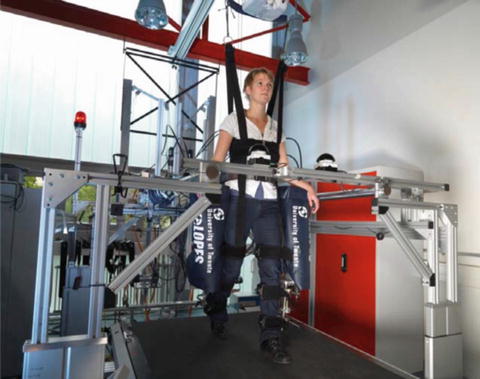

Fig. 10.6
LOPES exoskeleton (Published with permission from the University of Twente)
The Active Limb Exoskeleton I and II (ALEX I and ALEX II), shown in Fig. 10.7 are devices developed at the University of Delaware. ALEX I is a motorized exoskeleton, which modulates the foot trajectory using motors at the hip (for flexion/extension and abduction/adduction) and the knee (for flexion/extension), and a force field at the foot which helps in gait training. Alex’s flexible design allows ankle dorsiflexion/plantarflexion and inversion/eversion motions [5, 10, 41, 43–45]. This device has three types of controllers: trajectory tracking PD controller; set-point PD controller; and force-field controller [5]. ALEX I can only be worn on the right side while ALEX II can be used on the subject’s right or left leg, and allows several adjustments, improving fit to the user [42].
A unilateral and supportive arm for ankle assistance, BWS and human-robot interaction was developed by researchers of the Vrije Universiteit Brussel in Belgium. This exoskeleton has three DoFs (one DOF joint for ankle, knee and hip). Only the knee joint is powered by pleated pneumatic artificial muscles. A strap-on the footplate helps with actuator force transfer during stance and for better fitting. A Proxy-based Sliding Mode Control (PSMC) is used as a trajectory-tracking based approach to gait training of SCI patients with poor motor control. It was proposed in view of the system’s safety requirements and envisaged compliant behavior [46].
The Tibion® PK100 bionic leg orthosis (now called the AlterG Bionic Leg), commercialized by the Tibion Corporation (now part of AlterG, http://www.tibion.com/), is a wearable, portable and lightweight (constructed of carbon fiber) device for rehabilitation of patients affected by neurological conditions such as stroke. This powered leg orthosis includes a high-torque actuator, electronics, sensors, and embedded firmware. This battery powered device supplies the force to assist or resist leg extension and flexion. The device provides multiple modes of operation including automatic assistance, manual assistance, continuous passive motion and robotic therapy for the knee. The biomechanical algorithms make use of information from pressure sensors in the foot in order to determine when the patient requires extra assistance or high forces for active assistance during sit-to-stand transfers, stair ascent/descent, and walking.
The Active Knee Rehabilitation Orthotic System (ANdROS), shown in Fig. 10.8, developed in Prof. Mavroidis’ Laboratory at Northeastern University in Boston, MA is a wearable and portable assistive tool for gait rehabilitation and monitoring of people with motor control deficits due to a neurological ailment, such as stroke. ANDROS reinforces a desired gait pattern by continually applying a corrective torque around the knee joint, commanded by an impedance controller. A sensorized yet unactuated brace worn on the unimpaired leg is used to synchronize the playback of the desired trajectory based on the user’s intent. The device is mechanically grounded through two Ankle Foot Orthoses (AFOs) rigidly attached to the main structure, that help reduce the weight perceived by the user [47].
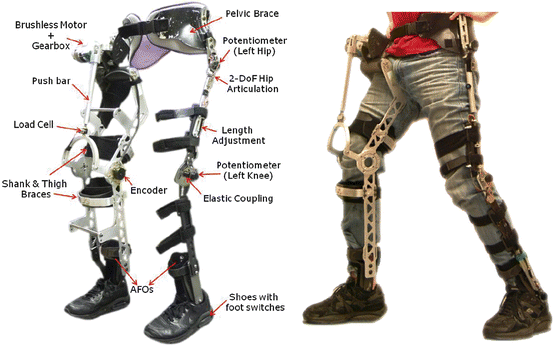

Fig. 10.8




Active knee rehabilitation orthotic system (ANdROS) (Published with permission from Prof. Mavroidis, Northeastern University, Boston, MA)
Stay updated, free articles. Join our Telegram channel

Full access? Get Clinical Tree



